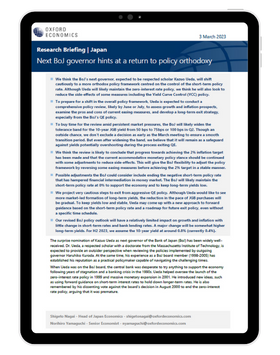Next BoJ governor hints at a return to policy orthodoxy

We think the BoJ’s next governor, expected to be respected scholar Kazuo Ueda, will shift cautiously to a more orthodox policy framework centred on the control of the short-term policy rate. Although Ueda will likely maintain the zero-interest rate policy, we think he will also look to reduce the side-effects of some measures including the Yield Curve Control (YCC) policy.
What you will learn:
- To buy time for the review amid persistent market pressures, the BoJ will likely widen the tolerance band for the 10-year JGB yield from 50 bps to 75bps or 100 bps in Q2. Though an outside chance, we don’t exclude a decision as early as the March meeting to ensure a smooth transition period. But even after widening the band, we believe that it will remain as a safeguard against yields potentially overshooting during the process exiting QE.
- We think the review is likely to conclude that progress towards achieving the 2% inflation target has been made and that the current accommodative monetary policy stance should be continued with some adjustments to reduce side-effects. This will give the BoJ flexibility to adjust the policy framework by reversing some easing measures before achieving the 2% target in a stable manner.
- Possible adjustments the BoJ could consider include ending the negative short-term policy rate that has hampered financial intermediation in money market. The BoJ will likely maintain the short-term policy rate at 0% to support the economy and to keep long-term yields low.
- We project very cautious steps to exit from aggressive QE policy. Although Ueda would like to see more market-led formation of long-term yields, the reduction in the pace of JGB purchases will be gradual.
- Our revised BoJ policy outlook will have a relatively limited impact on growth and inflation with little change in short-term rates and bank lending rates.
Tags:
Related Resouces

Post
Tariffs and Politics Leave the BoJ Powerless in Japan
The Bank of Japan kept its policy rate at 0.5% at its July meeting. We continue to think the BoJ will exercise caution on rate hikes despite still-high inflation and a recent trade deal with the US.
Find Out More
Post
US-Japan Trade Deal Fails to Shift Japan’s Growth Outlook
We estimate that the US's effective tariff rate on Japanese products is around 17%, in line with our baseline assumption. Lower tariffs on autos are a positive, given the sector's significant contribution to the economy and its broad domestic supporting base
Find Out More
Post
Japan’s Rising Political Instability Will Undermine Fiscal Discipline
The ruling Liberal Democratic party (LDP) and its partner Komeito lost their majority in Japan's upper house elections on July 20. Although Prime Minister Shigeru Ishiba will likely stay to avoid political gridlock, especially to complete tariff negotiations with the US, the political situation has become fluid and could lead to a leadership change or the reshuffling of the coalition.
Find Out More